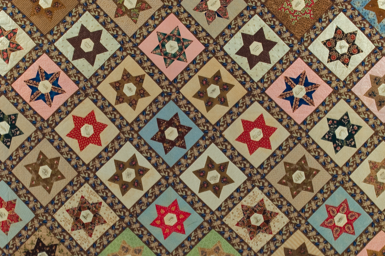
The International Quilt Study Center and Museum will present the exhibition "Elegant Geometry: American and British Mosaic Patchwork" May 28 through Jan. 8. The exhibition is curated by British quilt historian Bridget Long.
Mosaic quilts are eye-dazzling textiles made from thousands of precisely-shaped fabric patches formed with the use of paper templates. The technique was used in the British Isles as early as the 1700s and also became popular in other parts of Europe, as well as Britain's North American colonies. This exhibition traces the development of the style and presents many stunning examples of an exacting and time-consuming art.
The 18th century was the period when British patchwork blossomed as a domestic decorative needlecraft. Mosaic patchwork was made first with silks and wools, then later with cotton and linens as the taste for printed cloths grew at the end of the century. Most surviving mosaic patchwork from this period was made by wrapping fabric pieces over paper pieces then whipstitching them together. The technique allowed the maker to use virtually any shape to create elaborate figurative imagery. Most makers, however, chose to make mosaic patchwork of tessellated (tiled or repeating) patterns, most often using hexagons, triangles and diamonds.
The technique, often referred to as paper piecing, was transported to North America with British settlers and through the continued cultural exchange between the United States and Britain. Using items in the IQSCM collection drawn from both sides of the Atlantic, the exhibition considers the use of the mosaic patchwork technique into the 20th century and will include an 1844 signature quilt from a prominent Quaker family, the Scattergoods, as well as one of the earliest quilts in the collection, a 1796 hexagon mosaic by Anna Ruggles of the UK.
Visitors will enjoy learning about an early quilt style, connecting it to familiar styles today such as the "Grandmother's Flower Garden" pattern. The exhibition will reveal many interconnections between American quiltmaking and its British roots.
Free audio tours of the exhibition will be available as will a full-color catalog of the exhibition. Public tours are offered free with admission Tuesdays through Saturdays at 11 a.m. and Saturdays at 1 p.m. Other programming associated with the exhibition includes:
June 26, 2 p.m. - Public lecture, "Elegant Geometry: American and British Mosaic Patchwork," Bridget Long, British quilt historian and guest curator of the exhibition
Aug. 23, noon - Tuesday Talk, "Chinese Mosaic Patchwork," curator of exhibitions, Marin Hanson
Sept. 11, 1:30-3:30 p.m. - Workshop, "Tessellations and Variations: Creating One and Two Patch Quilts," details at http://www.quiltstudy.org
Oct. 1, 10 a.m.-noon or 2-4 p.m. - Workshop, "American Girls Discover Geometric Shapes in Quilts," details at http://www.quiltstudy.org
Oct. 25, noon - Tuesday Talk, "The Art and Science of Patchwork Tessellations," Barbara Caron, IQSCM assistant director
Financial support for this exhibition is provided by the Cooper Foundation and the Robert and Ardis James Foundation.
The International Quilt Study Center is an academic program of the Department of Textiles, Clothing and Design in the UNL College of Education and Human Sciences.
- Maureen Ose, International Quilt Study Center and Museum
More details at: http://www.quiltstudy.org